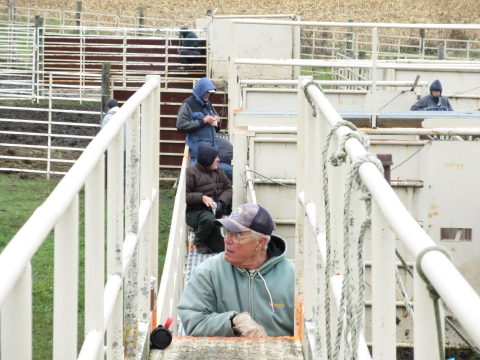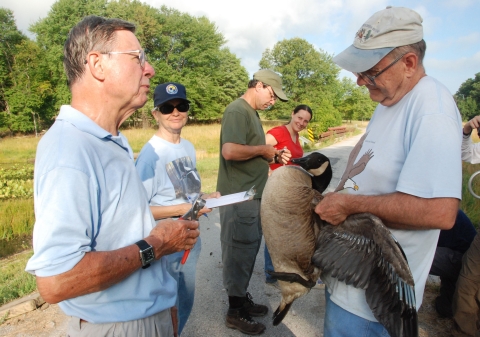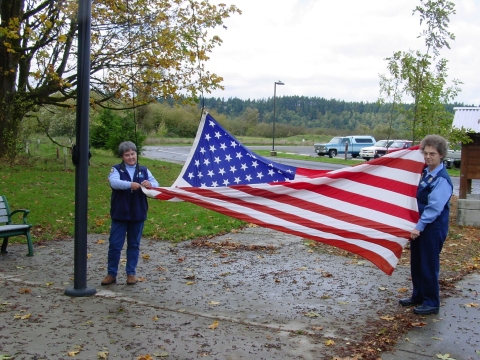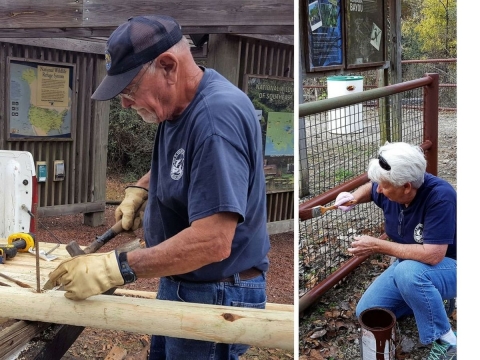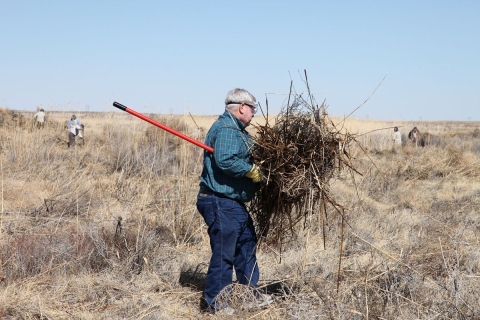What would national wildlife refuges do without volunteers to help greet visitors, staff events, maintain trails and conserve wildlife habitat? Less. Much less.
And then there are the super volunteers — people who donate an amazing 10,000 hours or more of their time to refuges. That amounts to roughly five years of full-time work, according to the Office of Personnel Management. By a common estimate, those 10,000 hours represent a $240,000 savings to refuges.
What leads some refuge volunteers to give so much of themselves, week after week, year after year — often well past retirement age?
The answers are as varied as the people who do it. Meet a few of the National Wildlife Refuge System’s remarkable 10,000-plus-hour club members.
Chuck and Betty Mulcahy, National Elk Refuge, Wyoming — 11,000+ hours each
Past professions: Airline ground operations (Chuck); flight attendant and dental assistant (Betty)
Volunteer tasks include: Radio track wolves and ungulates (hooved mammals); monitor trumpeter swan nests; use their skills as trained naturalists to excite visitors about refuge wildlife.
Why they volunteer: “Refuges are really jewels. It’s so good to build respect and interest for them.” — Chuck
What they like best: Interacting with visitors. “We’ve never gotten blasé about doing what we do. I like to feel I’m seeing all of this for the first time, as many visitors are. We try to feed that passion …” — Chuck. “[Working for the refuge] is good for us. It’s a symbiotic relationship.” — Betty
Moment to treasure: “We climb the butte once a week and wait ’til we can see all the swans and cygnets. We mark where they are on a map.” — Betty
Said of them: “They’re stellar volunteers … They inspire our visitors to want to know more.” — Natalie Fath, former volunteer coordinator, National Elk Refuge
Larry Fudge, Neal Smith National Wildlife Refuge, Iowa — 11,000+ hours (Note: Larry Fudge retired in 2021 as a refuge volunteer.)
Past profession: Junior high school science teacher; principal; school superintendent
Volunteer tasks include: Collects and cleans harvested seeds; takes part in annual bison roundup and screening; maintains trails; promotes refuge to community groups; clears invasive trees with a chainsaw and stump grinder to help restore endangered oak savanna
Why he volunteers: “It gives me a chance to work outside … Also, I like working with people … To show how much I appreciate them, every Monday I take a 9-by-13 pan of brownies I make and share them with refuge employees and volunteers.”
Moments to treasure: When barn owls began using a nesting box he built for them. “That was pretty exciting.”
Said of him: “An amazing worker, dedicated and talented … a great refuge ambassador.” — Nancy Corona, visitor services manager, Neal Smith Refuge
Frank McGilvrey, Patuxent Research Refuge, Maryland — 27,000 hours (Note: Long-time Patuxent Refuge volunteer Frank McGilvrey died in June 2020. This profile was written before his death.)
Past profession: Wildlife research biologist, Patuxent Refuge
Volunteer tasks include: Weekly waterbird surveys; songbird and wood duck nest box surveys; invasive plant removal
What he likes best: “I really enjoy working with young people. [He mentored nearly 100 interns over the years.] They’re so bright-eyed and bushy-tailed.”
Moments to treasure: Watching otters play. Watching a red fox catch a Canada goose. “You never know for sure what you’re going to find.”
Advice to others on volunteering: Biological fieldwork “can be strenuous …. You can’t mind the ticks, the deer flies, the [mo]squitoes, getting dirty, being sweaty… If you’re not willing to get down and dirty, you can’t be a lot of help [in the field]… As long as I’m having fun, I’ll keep doing it.”
Said of him: He’s “a human dynamo.” — Patuxent Refuge volunteer coordinator Diana Ogilvie
Karen Yochem, Billy Frank Jr. Nisqually National Wildlife Refuge, Washington — 18,000 hours
Past profession: Secretary, state government
Volunteer tasks include: Greeting visitors; answering phones; collecting fees
Why she volunteers: “It’s such a joy to work here. That’s why I’ve stayed as long as I have.”
What she likes best: “I get to see lots of people, talk to them … We get all kinds of questions. I try to come up with the right answers.”
Long view: Volunteering at the refuge has “really helped me as much as I’ve maybe helped the refuge. It gives me a reason to get up every day … It’s just a real pretty picture down here.”
Said of her: “She is our rock.” — Glynnis Nakai, project leader, Nisqually Refuge Complex
Wally and Carolyn Sternberg, Southeast Louisiana National Wildlife Refuges— 14,000+ hours each
Past professions: Power station chemist (Wally); banking and direct sales (Carolyn)
Tasks they’ve handled: Maintenance; cleanup; habitat restoration; special events
Why they volunteer: “We work as a team… It’s a pretty exciting way to spend our time.” — Carolyn
What they like best: “We’re out in the country. No lights, no traffic, no noises… We talk with [visitors]. I enjoy that. And the staff is great.” — Carolyn. “It’s fun to go back to the places and see how you’re made a difference. Especially with boardwalks; some section we had to completely rebuild.” — Wally
Moment to treasure: “Air boat rides and laughing with [deputy project leader] Pon [Dixson]. Finding flying squirrels in the nest boxes. Kayaking out to Lake Pontchartrain. Overnight trips to Bayou Teche, Delta and Atchafalaya Refuges.” — Carolyn and Wally
Said of them: They are “absolutely amazing.” — Becky Larkins, supervisory refuge ranger, Southeast Louisiana National Wildlife Refuges Complex
Jim Montgomery, Bitter Lake National Wildlife Refuge, New Mexico — 15,000+ hours
Past profession: Biology instructor, junior college; instructor, New Mexico Military Institute
Volunteer tasks include: Monitoring lesser sandhill cranes and interior least terns; weekly crane counts and roost counts; small mammal surveys
Why he volunteers: “I get pleasure out of doing it, and I feel like I’m doing something worthwhile … If I had [the decision] to do over, I would do it again.”
Moment to treasure: “Watching 10,000 cranes take off within 30 minutes.”
Said of him: “He’s our sandhill crane expert. He’s a walking encyclopedia … a fixture to the refuge … He’s a go-to guy all the time.” — Steve Alvarez, outdoor recreation planner, Bitter Lake Refuge
Reese Lukei, Back Bay National Wildlife Refuge, Virginia — 10,000 hours
Past professions: Certified public accountant and professional musician
Volunteer tasks include: Wood building (pole barns, kiosks, fishing piers; boardwalk trails) and maintenance; bird banding; supervising nine-person volunteer maintenance team; tracking raptors, including eagles and peregrine falcons; nature interpretation
Why he volunteers: “I’ve always been an outdoorsman … I like nature, particularly birds. My wife says it’s an incurable disease.”
What he likes best: “The camaraderie with the guys on the crew … With every project, if there are six of us on the job, there are six opinions. As long as they do it my way, everything’s okay.”
Long view: “Volunteering at a refuge is one of the most satisfying things a person can do that benefits both wildlife and people. That is why the crew has been together for 25 years… Our wives renamed us Reese’s Pieces, which the guys hate. They bought us orange hats. None of us will wear them.”
Said of him: “An invaluable volunteer for over 30 years … Back Bay Refuge would be unrecognizable were it not for his dedication, hard work and love.” — Erica Ryder, visitor services specialist, Back Bay Refuge


